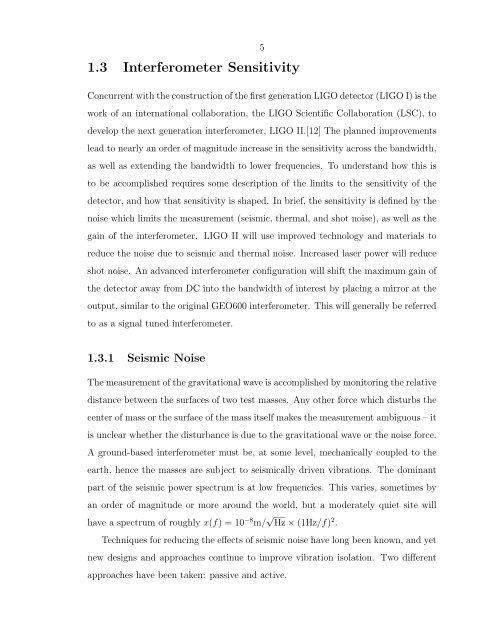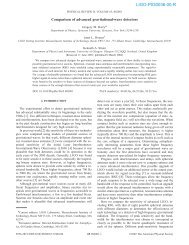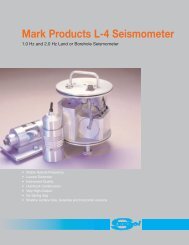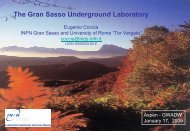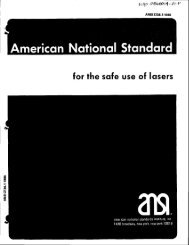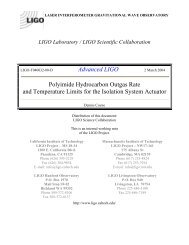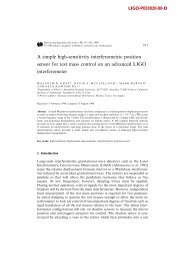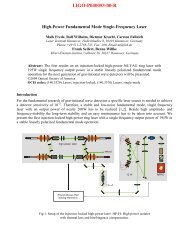- Page 1 and 2: Signal Extraction and Optical Desig
- Page 3 and 4: Abstract iii The LIGO project is tw
- Page 5 and 6: v Of course, one couldn’t last si
- Page 7 and 8: vii 2.3.2 Optimized Broadband . . .
- Page 9 and 10: ix 5.7.2 Narrowband RSE . . . . . .
- Page 11 and 12: xi 3.11 Signal cavity spectral sche
- Page 13 and 14: xiii D.7 Michelson compensation boa
- Page 15 and 16: xv 4.2 Effective response of the mi
- Page 17 and 18: 2 into which a stone has been dropp
- Page 19: 4 but no smoke). These tricks have
- Page 23 and 24: 8 The various terms are defined as
- Page 25 and 26: Pendulum Thermal Noise 10 The test
- Page 27 and 28: 12 back-action force on the inciden
- Page 29 and 30: 14 Scatter and absorption of coatin
- Page 31 and 32: 16 Another feature of signal tuned
- Page 33 and 34: 18 A scheme for controlling the fiv
- Page 35 and 36: Laser PD1 PD2 ¦¡¦ ¥¡¥ PRM +
- Page 37 and 38: 22 known as the detuning phase. The
- Page 39 and 40: 24 cavity induces a phase shift upo
- Page 41 and 42: 26 of the first cavity, then for a
- Page 43 and 44: Frequency (Hz) 5000 4000 3000 2000
- Page 45 and 46: 0.8 0.6 0.4 0.2 0 −4 φ sec 1 6 5
- Page 47 and 48: the mirror is 32 i2k(l+δl/2 cos(ω
- Page 49 and 50: The shot noise current spectral den
- Page 51 and 52: 36 depends on the choice of ITM, up
- Page 53 and 54: 38 mirror is calculated based on th
- Page 55 and 56: 40 This is not the transmissivity o
- Page 57 and 58: Cavity reflectivity 1 0.9 0.8 0.7 0
- Page 59 and 60: 44 For high frequency response, bot
- Page 61 and 62: 46 Although this is a tiny signal,
- Page 63 and 64: Strain sensitivity (h(f)/rtHz) 10
- Page 65 and 66: 50 sources the interferometer would
- Page 67 and 68: Chapter 3 Signal Extraction 52 The
- Page 69 and 70: photodiode is proportional to 54 |E
- Page 71 and 72:
56 The demodulation phase β = 0 is
- Page 73 and 74:
58 to the difference in the rates o
- Page 75 and 76:
60 out of the amplitude of the audi
- Page 77 and 78:
62 is non-zero. This is the basic f
- Page 79 and 80:
64 further to generate the second o
- Page 81 and 82:
The source amplitude is set by the
- Page 83 and 84:
68 of their sum and difference, or
- Page 85 and 86:
however, is given by 70 φ− = Ω
- Page 87 and 88:
72 transmittance is then higher tha
- Page 89 and 90:
74 resonance, for both upper and lo
- Page 91 and 92:
76 due to the fluctuating length of
- Page 93 and 94:
78 the hash marks corresponding to
- Page 95 and 96:
sensitive to differential signals,
- Page 97 and 98:
Laser �§�� � �§� rp
- Page 99 and 100:
compound mirror. The derivatives of
- Page 101 and 102:
freedom. 86 N ′ = 1 ∂rc −irc
- Page 103 and 104:
88 The φs degree of freedom is qui
- Page 105 and 106:
care must be applied to this questi
- Page 107 and 108:
92 The magnitude likewise doesn’t
- Page 109 and 110:
94 Φ+ Φ− φ+ φ− φs Refl 81
- Page 111 and 112:
96 10 more than this. With a transm
- Page 113 and 114:
98 factor to Φ+, which was ∼ 500
- Page 115 and 116:
100 Degree of freedom Residual leng
- Page 117 and 118:
3.5 Conclusions 102 Designing the R
- Page 119 and 120:
Chapter 4 104 The RSE Tabletop Prot
- Page 121 and 122:
106 Two input test masses (ITM) and
- Page 123 and 124:
108 a CVI W1-1064 window, AR coated
- Page 125 and 126:
110 order diffracted beam. Although
- Page 127 and 128:
112 Reflected 81 Reflected 54 Picko
- Page 129 and 130:
114 combination of the PRM and SM1
- Page 131 and 132:
116 from ETM2 and SM5. A box of ele
- Page 133 and 134:
118 output roughly +18 dBm, while t
- Page 135 and 136:
120 The reflected powers are used t
- Page 137 and 138:
122 Waist size (mm) Waist position
- Page 139 and 140:
124 characterized mirrors, alignmen
- Page 141 and 142:
126 completely different mixer, and
- Page 143 and 144:
128 on with minimal gain and using
- Page 145 and 146:
130 for the φ− servo, hand tunin
- Page 147 and 148:
132 matrix to imperfections in thes
- Page 149 and 150:
RF photodiodes L.O. BLP-5 5 MHz low
- Page 151 and 152:
136 modeled matrix are the demodula
- Page 153 and 154:
138 the dual-recycled Michelson. Th
- Page 155 and 156:
140 4.5.3 Gravitational Wave Transf
- Page 157 and 158:
Relative Magnitude Relative Phase (
- Page 159 and 160:
144 an offset can be estimated. The
- Page 161 and 162:
146 Many aspects of the process of
- Page 163 and 164:
148 the detuned case is more compli
- Page 165 and 166:
150 different, and these terms do n
- Page 167 and 168:
152 where there (ideally) is no car
- Page 169 and 170:
154 equivalent to shot noise, isign
- Page 171 and 172:
156 The laser field can be expanded
- Page 173 and 174:
Φ+ = φ3 + φ4 Φ− = φ3 − φ4
- Page 175 and 176:
160 Eq. (5.15) will then be evaluat
- Page 177 and 178:
DC Carrier Term 162 It’s useful t
- Page 179 and 180:
164 of interest, then, the noise si
- Page 181 and 182:
166 transmissivity terms. Eq. (5.15
- Page 183 and 184:
168 match the detuning phase for th
- Page 185 and 186:
170 A second subscript, I or Q, wil
- Page 187 and 188:
each noise source. 5.7 Analysis 172
- Page 189 and 190:
174 the demodulation phase. This is
- Page 191 and 192:
176 noise, the frequency noise spec
- Page 193 and 194:
Amplitude noise (arb. units) Freque
- Page 195 and 196:
180 ferential length RMS fluctuatio
- Page 197 and 198:
182 characterizes the fringe width
- Page 199 and 200:
A.1.1 Cavity Coupling 184 One of th
- Page 201 and 202:
186 A.1.2 Cavity Approximations The
- Page 203 and 204:
esonance. 188 rcanti−res. = rf +
- Page 205 and 206:
190 where the primed parameters ref
- Page 207 and 208:
Magnitude Phase (degrees) 10 0 10
- Page 209 and 210:
194 The magnitude of the transmitte
- Page 211 and 212:
196 Where As is 1 − Ls, or one mi
- Page 213 and 214:
198 The beamsplitter is typically v
- Page 215 and 216:
200 closed loop gain of the control
- Page 217 and 218:
202 Substitution and some algebra m
- Page 219 and 220:
204 Defining the phases for the RF
- Page 221 and 222:
Appendix C 206 Cross-Coupled 2 × 2
- Page 223 and 224:
208 the coupling due to the second
- Page 225 and 226:
to the disturbance at d1. 210 ⎛
- Page 227 and 228:
212 The measurement is also assumed
- Page 229 and 230:
214 is replaced with a 1 µF capaci
- Page 231 and 232:
216 Figure D.2: PZT compensation sc
- Page 233 and 234:
218 Figure D.4: PZT compensation sc
- Page 235 and 236:
220 Figure D.6: PZT compensation sc
- Page 237 and 238:
Input Test In 1 kΩ 1 kΩ − + 1
- Page 239 and 240:
Figure D.10: RF frequency generatio
- Page 241 and 242:
Bibliography 226 [1] J. Weber. Dete
- Page 243 and 244:
228 [19] Yuk Tung Liu and Kip S. Th
- Page 245 and 246:
230 [38] T.T. Lyons, M.W. Regehr, a
- Page 247:
232 [60] J.E. Mason. Noise coupling


